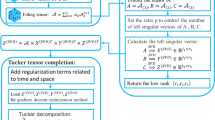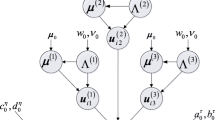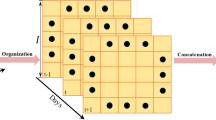Abstract
The capacity of fully exploiting underlying spatial-temporal dependencies holds the key for missing traffic data imputation, however, previous studies have neglected the residual information from recovery models. To refine this task, we propose a spatial-temporal bi-directional residual optimisation (ST-BiRT) model on the basis of tensor decomposition to effectively improve the imputation performance. The novelty of our approach concentrates on a well-designed bi-directional residual structure, which reduces model errors dramatically. We can greatly exploit the potential of the optimisation structure by dynamically stacking massive residual units, thereby significantly enhancing the recovery capability. When faced with various combinations of missing scenario and missing rate problems, ST-BiRT model can perform with better accuracy and robustness. Here, the experiments on the Guangzhou traffic speed dataset demonstrate that the proposed ST-BiRT model outperforms the state-of-the-art baseline models. In addition, the mechanism of the bi-directional residual optimisation can address extreme cases and their evaluation metrics can reach acceptable values even when the missing rate exceeds 90%. Finally, the superiority of the ST-BiRT model in repairing loss or low-quality traffic data is confirmed by visualising the experimental results.














Similar content being viewed by others
References
Lee D, Shin K (2021) Robust factorization of real-world tensor streams with patterns, missing values, and outliers. In: 2021 IEEE 37th International Conference on Data Engineering (ICDE). IEEE, pp 840-851
Tan H, Feng G, Feng J, Wang W, Zhang YJ, Li F (2013) A tensor-based method for missing traffic data completion. Transp Res Part C: Emerg Technol 28:15–27
Bae B, Kim H, Lim H, Liu Y, Han LD, Freeze PB (2018) Missing data imputation for traffic flow speed using spatio-temporal cokriging. Transp Res Part C Emerg Technol 88:124–139
Chen X, He Z, Sun L (2019) A Bayesian tensor decomposition approach for spatiotemporal traffic data imputation. Transp Res Part C: Emerg Technol 98:73–84
Li H, Li M, Lin X, He F, Wang Y (2020) A spatiotemporal approach for traffic data imputation with complicated missing patterns. Transp Res Part C: Emerg Technol 119:102730
Zhang T, Zhang DG, Yan HR, Qiu JN, Gao JX (2021) A new method of data missing estimation with FNN-based tensor heterogeneous ensemble learning for internet of vehicle. Neurocomputing 420:98–110
Chen X, Sun L (2021) Bayesian temporal factorization for multidimensional time series prediction. IEEE Trans Pattern Anal Mach Intell
Yang H, Yang J, Han LD, Liu X, Pu L, Chin SM, Hwang HL (2018) A Kriging based spatiotemporal approach for traffic volume data imputation. PLoS One 13(4):e0195957
Laña I, Olabarrieta II, Vélez M, Del Ser J (2018) On the imputation of missing data for road traffic forecasting: New insights and novel techniques. Transp Res Part C: Emerg Technol 90:18–33
Yoon J, Jordon J, Schaar M (2018) Gain: Missing data imputation using generative adversarial nets. In: International Conference on Machine Learning. PMLR, pp 5689-5698
Cui Z, Ke R, Pu Z, Wang Y (2020) Stacked bidirectional and unidirectional LSTM recurrent neural network for forecasting network-wide traffic state with missing values. Transp Res Part C: Emerg Technol 118:102674
Xu D, Wei C, Peng P, Xuan Q, Guo H (2020) GE-GAN: A novel deep learning framework for road traffic state estimation. Transp Res Part C: Emerg Technol 117:102635
Xu D, Wang Y, Peng P, Beilun S, Deng Z, Guo H (2020) Real-time road traffic state prediction based on kernel-KNN. Transp A: Transp Sci 16(1):104–118
Qu L, Zhang Y, Hu J, Jia L, Li L (2008) A BPCA based missing value imputing method for traffic flow volume data. In: 2008 IEEE Intelligent Vehicles Symposium. IEEE, pp 985-990
Qu L, Li L, Zhang Y, Hu J (2009) PPCA-based missing data imputation for traffic flow volume: A systematical approach. IEEE Trans Intell Transp Syst 10(3):512–522
Ma S, Goldfarb D, Chen L (2011) Fixed point and Bregman iterative methods for matrix rank minimization. Math Program 128(1):321–353
Li Y, Li Z, Li L, Zhang Y, ** M (2013) Comparison on PPCA, KPPCA and MPPCA based missing data imputing for traffic flow. In: ICTIS 2013: Improving Multimodal Transportation Systems-Information, Safety, and Integration, pp 1151-1156
Tang K, Tan C, Cao Y, Yao J, Sun J (2020) A tensor decomposition method for cycle-based traffic volume estimation using sampled vehicle trajectories. Emerg Technol, Transp Res Part C 118:102739
Liu J, Musialski P, Wonka P, Ye J (2012) Tensor completion for estimating missing values in visual data. IEEE Trans Pattern Anal Mach Intell 35(1):208–220
Ran B, Tan H, Wu Y, ** PJ (2016) Tensor based missing traffic data completion with spatial–temporal correlation. Phys A: Stat Mech Appl 446:54–63
Chen X, Lei M, Saunier N, Sun L (2021) Low-rank autoregressive tensor completion for spatiotemporal traffic data imputation. ar**v preprint ar**v:2104.14936
Chen X, Yang J, Sun L (2020) A nonconvex low-rank tensor completion model for spatiotemporal traffic data imputation. Transp Res Part C Emerg Technol 117:102673
Chen X, He Z, Wang J (2018) Spatial-temporal traffic speed patterns discovery and incomplete data recovery via SVD-combined tensor decomposition. Transp Res Part C Emerg Technol 86:59–77
Chen X, He Z, Chen Y, Lu Y, Wang J (2019) Missing traffic data imputation and pattern discovery with a Bayesian augmented tensor factorization model. Transp Res Part C Emerg Technol 104:66–77
Li Q, Tan H, Jiang Z, Wu Y, Ye L (2021) Nonrecurrent traffic congestion detection with a coupled scalable Bayesian robust tensor factorization model. Neurocomputing 430:138–149
Li L, Zhang J, Wang Y, Ran B (2018) Missing value imputation for traffic-related time series data based on a multi-view learning method. IEEE Trans Intell Transp Syst 20(8):2933–2943
Li L, Du B, Wang Y, Qin L, Tan H (2020) Estimation of missing values in heterogeneous traffic data: Application of multimodal deep learning model. Knowl Based Syst 194:105592
Ma T, Antoniou C, Toledo T (2020) Hybrid machine learning algorithm and statistical time series model for network-wide traffic forecast. Transp Res Part C Emerg Technol 111:352–372
Lv Z, Li J, Li H, Xu Z, Wang Y (2021) Blind travel prediction based on obstacle avoidance in indoor scene. Wirel Commun Mob Comput 2021
Basly H, Ouarda W, Sayadi FE, Ouni B, Alimi AM (2021) DTR-HAR: deep temporal residual representation for human activity recognition. Vis Comput 1–21
Du B, Peng H, Wang S, Bhuiyan MZA, Wang L, Gong Q, … Li J (2019) Deep irregular convolutional residual LSTM for urban traffic passenger flows prediction. IEEE Trans Intell Transp Syst 21(3):972-985
Zhang J, Zheng Y, Qi D (2017) Deep spatio-temporal residual networks for citywide crowd flows prediction. In: Thirty-first AAAI conference on artificial intelligence
Guo G, Zhang T (2020) A residual spatio-temporal architecture for travel demand forecasting. Transp Res Part C: Emerg Technol 115:102639
Lv Z, Li J, Dong C, Li H, Xu Z (2021) Deep learning in the COVID-19 epidemic: A deep model for urban traffic revitalization index. Data Knowl Eng 135:101912
Guo S, Lin Y, Li S, Chen Z, Wan H (2019) Deep spatial–temporal 3D convolutional neural networks for traffic data forecasting. IEEE Trans Intell Transp Syst 20(10):3913–3926
Song C, Lin Y, Guo S, Wan H (2020) Spatial-temporal synchronous graph convolutional networks: A new framework for spatial-temporal network data forecasting. In: Proceedings of the AAAI Conference on Artificial Intelligence, vol 34, no 01, pp 914-921)
Lv Z, Li J, Dong C, Zhao W (2020) A deep spatial-temporal network for vehicle trajectory prediction. In: International Conference on Wireless Algorithms, Systems, and Applications. Springer, Cham, pp 359-369
Yu B, Yin H, Zhu Z (2017) Spatio-temporal graph convolutional networks: A deep learning framework for traffic forecasting. ar**v preprint ar**v:1709.04875
Zhang H, Chen P, Zheng J, Zhu J, Yu G, Wang Y, Liu HX (2019) Missing data detection and imputation for urban ANPR system using an iterative tensor decomposition approach. Transp Res Part C: Emerg Technol 107:337–355
Kenneth GE (2021) Statistical application of regression techniques in modeling road accidents in Edo State, Nigeria. Sch J Phys Math Stat 1:14–18
Acknowledgements
This work was supported in part by the National Natural Science Foundation of P.R. China under Grant 52072130, in part by the National Natural Science Foundation of P.R. China under Grant 11702099.
Author information
Authors and Affiliations
Corresponding author
Ethics declarations
Conflict of interest
No conflict of interest exits in the submission of this paper.
Additional information
Publisher’s note
Springer Nature remains neutral with regard to jurisdictional claims in published maps and institutional affiliations.
Rights and permissions
About this article
Cite this article
Li, J., Xu, L., Li, R. et al. Deep spatial-temporal bi-directional residual optimisation based on tensor decomposition for traffic data imputation on urban road network. Appl Intell 52, 11363–11381 (2022). https://doi.org/10.1007/s10489-021-03060-4
Accepted:
Published:
Issue Date:
DOI: https://doi.org/10.1007/s10489-021-03060-4




